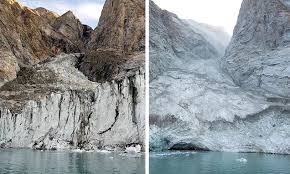Scientists discover cause of mega tsunami that shook the earth

George George Idowu
After months of speculation, scientists discovered the cause of a mysterious seismic event that shook the Earth for nine straight days in September 2023.
The culprit? A massive landslide that sent a mountaintop plunging into the sea in East Greenland, creating a “mega-tsunami” as tall as a skyscraper.
The 650-foot-tall wave destroyed around $200,000 worth of infrastructure at an unoccupied research station on Ella Island. Fortunately, no one was injured.
However, the disaster occurred near a commonly travelled cruise route, sparking concerns that had a ship been nearby. It could have been catastrophic.
Initially baffling scientists, the seismic activity unlike anything they had ever seen was traced back to the September landslide by an international team led by geologist Kristian Svennevig of the Geological Survey of Denmark and Greenland.
“When we set out on this scientific adventure, everybody was puzzled, and no one had the faintest idea what caused this signal,”
Svennevig said. The team published its findings today in the journal Science.
Researchers now believe climate change was a key factor in the collapse, as melting glaciers weakened the mountain’s stability. As global temperatures rise, similar catastrophic events could become more frequent in Earth’s polar regions.
Seismic networks first detected the unusual activity last year, noting that it oscillated with a 92-second interval, far too slow for humans to feel. The signal persisted for an unprecedented nine days much longer than the seconds-to-minutes lifespan of typical earthquakes.
Online discussions soon brought attention to a massive landslide that had occurred near a remote fjord in Greenland. By digitally reconstructing the event through seismic recordings, satellite imagery, and computer simulations, the team determined that the 33 million cubic yards of ice and rock crashing into the fjord created a mega-tsunami.
The waves repeatedly sloshed back and forth in the fjord, in a process known as “seiche,” which explained the prolonged seismic activity.
The findings highlight the growing threats posed by climate change, according to co-author Robert Anthony of the United States Geological Survey.
“It took geophysical observations and modelling from researchers across many countries to put the puzzle together.”
As co-author Alice Gabriel of the University of California San Diego warned, “Climate change is shifting what is typical on Earth, and it can set unusual events into motion.” The incident underscores the need for increased monitoring of polar regions as the planet continues to warm.
